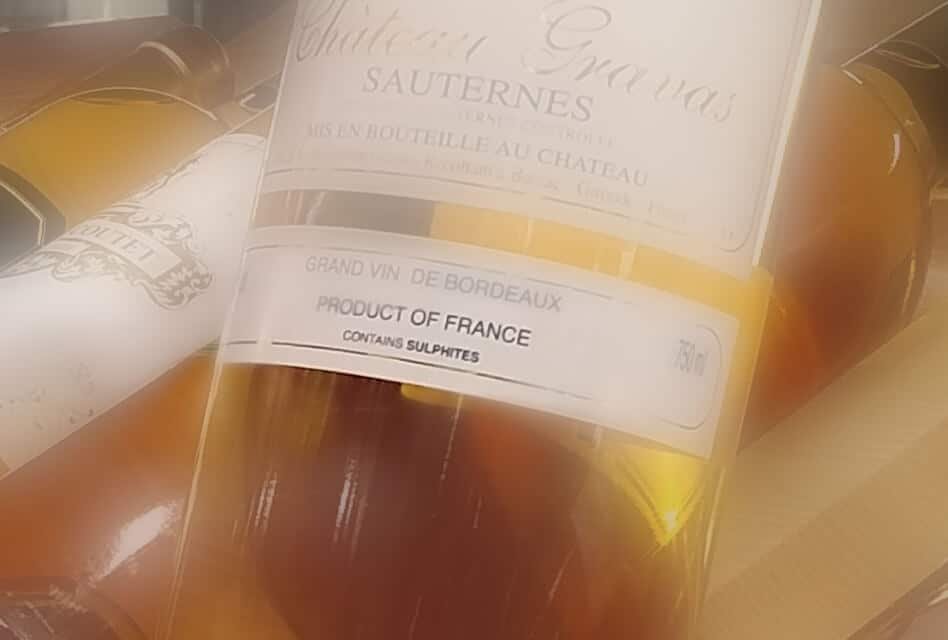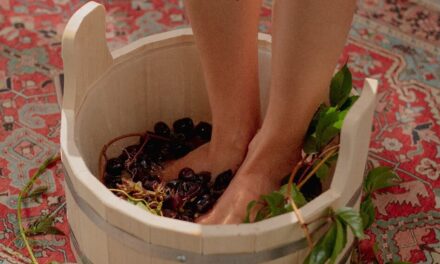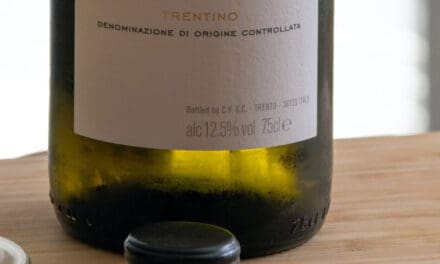Wine contains many substances that occur naturally in grapes. Others are created during the production process or artificially added by vintners. One of them, sulfite, has a terrible reputation. But are sulfites in wine actually harmful to you? And why are they in wine anyways?
Sulfite is a preservative that naturally occurs in many fruits, vegetables, and herbs. In wine, it occurs during fermentation. But it is also added artificially by vintners to make wine more durable.
Sulfite is also known as sulfur dioxide (chemical symbol: SO2). From a chemical point of view, it is a salt of sulfurous acid. When occurring in significant portions, it causes a pungent taste. That’s true for onions, leeks, or garlic.
Food producers have known sulfite as a preservative for a long time. Thousands of years ago, the Romans used to burn sulfur candles inside amphoras which were used to store foods and beverages. While burning, the candles produced SO2, which helped keep the amphoras’ content fresh.
Today, industrial food producers use sulfites for conserving dried fruits, pickled and canned foods, juices, marmalades, potato chips and similar snacks, and many other food items. And, of course, vintners use them to preserve wine.
WHAT DO SULFITES IN WINE DO?
Sulfites play a crucial role in wine. They work as preservatives that shield the wine from oxygen. That is an essential function because oxidation encourages the growth of bacteria and fungi. These microorganisms transform alcohol into acetic acid, which gives the wine a very unpleasant vinegar-like taste and ruins it. So by preventing bacteria from growing, sulfites help keep the wine fresh and prevent it from spoiling.
Besides that, sulfites can alter a wine’s aroma and even its color. For instance, SO2 encourages the creation of thiols. These compounds give wine aromas of bittersweet fruits such as grapefruit or passion fruit, as long as they occur in small portions. So if vintners want to add these flavors to their white wines, they can use sulfites to create them.
WHERE DO SULFITES IN WINE COME FROM?
Sulfites naturally occur in wine during the winemaking process, more specifically during fermentation. When the yeast transforms the sugar of the crushed grapes into alcohol, it creates SO2 as a byproduct.
The amount of natural sulfites in wine is relatively low, though. It is not enough to preserve the beverage for longer than a couple of months. So to increase their wines’ shelf life, vintners have to add sulfites artificially. They can do so at various stages of the winemaking process:
- They often add SO2 soon after or even while crushing the grapes. This approach prevents bacteria that might exist naturally in the grapes from creating acetic acid. In the worst case, these bacteria can spoil wine within hours. By adding SO2 in small doses, winemakers can minimalize this risk.
- During the first fermentation phase, sulfite levels usually drop. Thus, another addition might be necessary before continuing the process to prevent bacteria from spoiling the wine.
- When wines age for a long time in oak barrels, they typically need more sulfites. Vintners check the SO2 level regularly, and if necessary, they add more sulfites to make sure the wine won’t spoil.
- A final add-on can happen immediately before bottling. In case, the sulfites level has dropped too low, winemakers increase it to the optimal level.
ARE SULFITES IN WINE BAD FOR YOU?
Unlike many myths claim, sulfites in wine are absolutely harmless for most people. They do not have any health effects, neither in the short nor in the long term.
However, a small group can be sensitive to sulfite. According to a study by the University of Florida, less than 1% of the population might be prone to it. The risk is slightly higher for people who have preexisting conditions. For instance, about 5% of asthma patients experience breathing problems or asthma attacks when consuming food containing sulfites. Other possible reactions include headaches, hives, swelling of lips and mouth, and rash.
But as said before, only very few people are affected by these problems. And if you belong to this group, you probably already know because you have suffered reactions to other food items that contain sulfites. If you’re unsure, it makes sense to talk to your doctor.
Can Sulfites in Wine Cause Headaches?
Sulfite can cause headaches for people who are sensitive to sulfites. If you have never experienced any problems when consuming canned, pickled, or dried foods, it is rather unlikely that you are. It is more probable that the reason for your headaches is another component of wine, for instance:
- alcohol
- histamines
- tannins
HOW MUCH SULFITE IS IN WINE?
In the United States, the level of sulfites in wine ranges between 5 and 350 milligrams per liter. The precise level depends on the specific wine:
- Dry red wines of decent quality usually have about 50 to 75 mg per liter.
- Dry whites contain around 100 mg per liter.
- Because of their higher sugar contents, sweet wines need more sulfites to avoid further fermentation. Sweet reds can have up to 200 mg per liter, while sweet whites and rosés contain up to 250 mg.
- Dessert wines, especially those made from noble rot grapes, might have up to 300 mg per liter.
For comparison, let us have a look at other food items and their sulfite contents:
- 1 kilogram of French fries contains around 1,900 milligrams of sulfites.
- Canned soup ranges between 200 and 3,000 milligrams per liter.
- Dried fruits such as figs, apricots, or dates can have up to 3,500 milligrams per kilogram.
ITEM
SULFITE CONTENT
Amount of Sulfite in Wine and Food Items
Are There Sulfites in Organic Wine?
Small portions of natural sulfites occur in organic wines. They are created during the fermentation process, so they are inevitable. But vintners do not add sulfites artificially to organic wines. In the United States, the maximum sulfite level in organic wine is 10 milligrams per liter.
Are There Sulfites in Biodynamic Wine?
Biodynamic wines contain natural sulfites in small amounts. But vintners dedicated to biodynamic winemaking techniques do not add sulfites to their wines.
Are There Wines Without Sulfites?
There are no wines that are entirely free of sulfite. As it is a compound created during the fermentation process, it is impossible to make sulfite-free wine.
Some vintners try to keep the sulfite level as low as possible, though. They do not add sulfites artificially during the winemaking process. You can find several labels on wine bottles that indicate the absence of added sulfites:
- Organic Wines: According to regulations for organic winemaking by the USDA (and comparable authorities in other countries), sulfites are synthetic additives. So if vintners want to label their wines organic, they cannot use them. Besides, the natural level of sulfites cannot be higher than 10 milligrams per liter. Be aware that organic wine is not the same as “wine made from organically grown grapes”. For the latter, adding sulfites is permitted.
- Natural Wines: Although most governments do not regulate the use of the label “natural wine”, these wines typically do not contain any additives. So vintners do not increase their wines’ sulfite levels artificially.
- Low-Intervention Wines: Vintners who make low-intervention wines (also called: minimal-intervention wines) tend to follow the same procedures as natural wine producers. They abstain from sulfites as well as other additives.
- Biodynamic Wines: The same is true for biodynamic wine. There are no official rules for this label. However, some private institutions, such as the Demeter organization, certify wines that follow specific biodynamic rules. And these rules include the prohibition of added sulfites.
- No Added Sulfites Wines: This label is self-explanatory. No Added Sulfites wines (short: NSA wines) are made without additional sulfites. Unlike biodynamic or organic wines, they might contain other additives, though. Be aware that NSA isn’t a regulated label either.
Sulfites Level Regulations
In most wine countries, wine laws require vintners to state a warning on bottles if their wine exceeds a specific sulfite level. In the United States, that is true for wines with 10 milligrams per liter or more. In most cases, the warning reads “contains sulfites”. But you might come across other names in the contents declaration that all refer to sulfites:
- sulfur dioxide
- potassium bisulfate
- potassium metabisulfite
- sodium bisulfite
- sodium metabisulfite
- sodium sulfite
By U.S. law, regular table wine can contain up to 350 milligrams of sulfites per liter. Regulations in the European Union provide specific maximum levels for different types of wine. While dry red wines can have only 150 mg per liter, dessert wines may have up to 400 mg. The following table specifies the details:
WINE TYPE
MAX. SULFITES IN REDS
MAX. SULFITES IN WHITES & ROSÉS
Maximum Sulfite Levels per Wine Type according to European Union Regulations
HOW TO REDUCE SULFITES IN WINE?
You might find several products that claim to reduce sulfites in wine to make it more enjoyable for sensitive people. They come in numerous forms:
- Purifiers to attach to the bottleneck
- Filter membranes that look like teabags and sit in your wine glass
- Spoon-shaped wands to swirl around in your glass
- Liquids that you drip into your wine before drinking it
- Sprays to apply to your glass
Whether these items work or not is arguable. Some wine lovers claim they allow them to enjoy wine despite having a sulfite allergy. But others argue that the products are useless and, in some cases, cause more health problems than they solve. Also, some reviewers reported that their wines’ aromas changed negatively after applying the filtering items.
FINAL WORDS
Sulfites in wine are definitely not as bad as their reputation. They are harmless for most wine lovers, and they do have an essential function in winemaking. With the details from this article, you know about this function. And in case you prefer low-sulfite wine, you also know how to find it.






